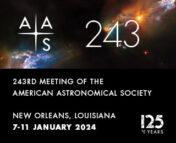In this series of posts, we sit down with a few of the keynote speakers of the 243rd AAS meeting to learn more about them and their research. You can see a full schedule of their talks here, and read our other interviews here!
Some of the most explosive phenomena in our universe are transients—events that change in brightness over a relatively short time, sometimes days or weeks, but other times only a fraction of a second. Studying transients requires “the power of teamwork in uncovering the mysteries of the universe,” according to Dr. Wen-fai Fong, who studies these exciting events.
Wen-fai Fong is currently a professor at Northwestern University and the Center for Interdisciplinary Exploration and Research in Astrophysics (CIERA). Her research focuses on some of the highest energy fast transients in our universe, including short gamma-ray bursts (SGRBs), kilonovae, and fast radio bursts (FRBs).

She is also the recipient of the 2024 Lancelot M. Berkeley–New York Community Trust Prize for Meritorious Work in Astronomy for her work in advancing our scientific understanding of these highly energetic transients and their host galaxies. Her prize lecture at AAS 243 will focus on fast transients. In her words, these are “objects in the universe that explode or merge and give transient emission on short timescales,” ranging from only a fraction of a second to several days.
The search for some of our Universe’s shortest bursts
Short gamma-ray bursts (SGRBs), which occur when two neutron stars collide and merge, are one of these fast transients. “A lot of my work and my group’s work really focuses on understanding this population of short gamma-ray bursts,” from what they tell us about merging neutron stars to the nucleosynthesis of the universe’s heaviest elements, says Professor Fong.
By studying SGRBs, her group aims to gain an understanding of their host galaxies and the processes happening to produce them. She is the co-PI of the SAGUARO collaboration, which is developing a follow-up procedure using telescopes in Arizona to search for the electromagnetic emission from merging neutron stars detected via gravitational waves. “Next time a neutron star merger happens, we’re going to be able to go through these steps, leverage all this archival data, and hopefully find the needle among the haystack pretty quickly,” she says.
Prof. Fong and her group also study another new type of fast transient: Fast Radio Bursts (FRBs). These very short (usually milliseconds long) and extremely energetic bursts have been the subject of much recent research, owing to the fact that we still don’t know for sure what causes them, despite many theories about their sources. “I’m really interested in understanding what their origins are, tracing them back to their host galaxies,” she says. Her group has recently released a paper localizing one of the most distant FRBs currently known (which she will discuss more in her AAS talk!).
She also emphasizes the importance of teamwork to truly get a picture of the physics happening for any of these fast transients. “You need to be able to react quickly and you can’t do everything by yourself,” she says. With many observers, “once we know an event of interest, then we record that piece of the sky in as many wavelengths as possible on a rapid timescale,” to give the team new insights into the physics taking place.
Path into astronomy
Prof. Fong was drawn to physics as a high school student, when she went to a pre-college summer camp for girls interested in physics at the University of Rochester. “That was hugely impactful, because it just showed me there were other girls out there who were super interested in physics,” she says. Additionally, as a high schooler, she joined the lab of Judith Pipher at the University of Rochester, who welcomed her with open arms. “She was my very first mentor in astronomy, and I didn’t realize how rare mentors like her were,” she says.
Now, as a professor, she has developed a pilot first-year seminar course at Northwestern titled “The Diverse Origins of Modern Astrophysics” for students in any major. This course encourages students to understand the diverse origins of astronomy and analyze who has historically benefited from opportunity and received recognition in astronomy. The course aims to get students “starting to think really critically about these issues early” in their career, regardless of field, she says.
Her advice to early career students is that sometimes a mentor/mentee match may not be a good fit, so “don’t let one bad experience keep you from pursuing a dream.” She also says, “especially for those from marginalized identities, or underrepresented identities, keep going” and encourages people to “be vocal about the shortcomings of our field, because that’s the only way we learn.”
To hear more about fast transients, tune into Wen-Fai Fong’s Plenary Lecture at 4:40 PM CT on Thursday, January 11 at #AAS243!
Edited by: Briley Lewis
Featured Image Credit: AAS


